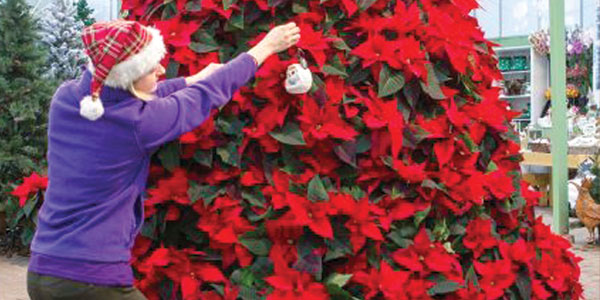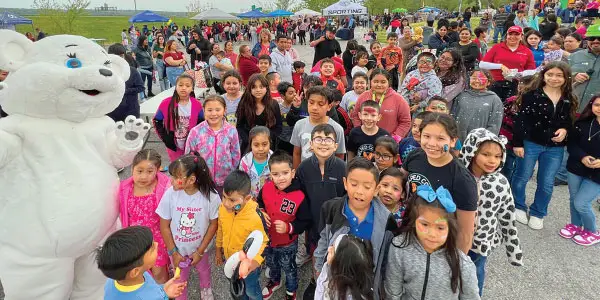
By Tere Siqueira
Christmas has weathered many twists throughout its long history.
Americans, for example, celebrate Christmas with a mixture of traditions that came together with the mixing of immigrant groups. Here are some American traditions with immigrant roots:
*Poinsettias: Native to Mexico, the plant known for its lush red leaves was brought to the United States by Joel Roberts Poinsett. The first U.S. ambassador to Mexico began growing the plants and giving them to people. The plant started growing in popularity.
There also is a Mexican legend about the relationship between poinsettias and Christmas. The legend claims that, during Christmas, a girl wanted to give Jesus Christ a gift and picked up a bouquet of weeds. Miraculously, they transformed into poinsettias. From that day on, they were known as the Flowers of the Holy Night.
*Gingerbread: An early type of gingerbread has its roots in the ancient Greek and Egyptian cultures. In the 11th century during the Crusades, gingerbread was brought from the Middle East to Europe. Making objects out of gingerbread is considered an art form in many European countries. German immigrants helped establish the making of gingerbread men and houses as a Christmas tradition in the United States.
*Eggnog: Now widely known as a traditional American drink, eggnog has its roots in Great Britain. During the Middle Ages, the drink was used to treat the flu. It also was consumed by the upper class. During the mid-1700s, the drink reached U.S. shores. During the late 1700s, George Washington became the first U.S. president to serve the drink during the holidays.
*Wrapping gifts: Wrapping gifts with paper has its origins in Asia, with the oldest pieces of wrapping paper being traced back to ancient China. Many centuries later, Clyde Hall and his brother Rollie invented modern gift-wrapping paper in their Kansas City, Missouri, store.
*Christmas stockings: The tradition of hanging stockings comes from Scandinavia, where children got candy when they were good, and has its roots in a fourth-century legend. St. Nicholas is believed to have helped three sisters by secretly providing gold to their poor father. According to the legend, he slipped into their home and put money in their stockings, which were drying by the fireplace. Eventually, children began hanging up stockings, hoping that Santa Claus – also nicknamed St. Nicholas – would visit them.
__________________________________________________________________________________________
Muchas de las tradiciones navideñas americanas tienen raíces inmigrantes
La Navidad ha resistido muchos giros a lo largo de su larga historia.
Los estadounidenses, por ejemplo, celebran la Navidad con una mezcla de tradiciones que se unieron con la mezcla de grupos de inmigrantes. Aquí hay algunas tradiciones americanas con raíces inmigrantes:
* Flores de Noche Buena: Originaria de México, la planta conocida por sus exuberantes hojas rojas fue traída a los Estados Unidos por Joel Roberts Poinsett. El primer embajador de EE. UU. en México comenzó a cultivar las plantas y a dárselas a las personas. La planta comenzó a crecer en popularidad.
También hay una leyenda mexicana sobre la relación entre las flores y la Navidad. La leyenda dice que, durante la Navidad, una niña quería darle un regalo a Jesucristo y recogió un ramo de hierbas. Milagrosamente, se transformaron en flores de pascua. A partir de ese día, fueron conocidas como las Flores de Noche Buena.
* Pan de jengibre: El pan de jengibre tiene sus raíces en las antiguas culturas griega y egipcia. En el siglo XI durante las Cruzadas, el pan de jengibre fue traído del Medio Oriente a Europa. Hacer objetos con pan de jengibre se considera una forma de arte en muchos países europeos. Los inmigrantes alemanes ayudaron a establecer la fabricación de hombres de pan de jengibre y casas como una tradición navideña en los Estados Unidos.
* Ponche de huevo (Rompope): Ampliamente conocido como una bebida tradicional estadounidense, el ponche de huevo tiene sus raíces en Gran Bretaña. Durante la Edad Media, la bebida se usaba para tratar la gripe. También fue consumido por la clase alta. A mediados de la década de 1700, la bebida llegó a las costas estadounidenses. A finales de 1700, George Washington se convirtió en el primer presidente de los Estados Unidos en servir la bebida durante las vacaciones.
* Envolver regalos: Envolver regalos con papel tiene su origen en Asia, y los trozos de papel de envoltura más antiguos se remontan a la antigua China. Muchos siglos después, Clyde Hall y su hermano Rollie inventaron papel moderno para envolver regalos en su tienda de Kansas City, Missouri.
* Botas navideñas: La tradición de colgar botas proviene de Escandinavia, donde los niños compraron dulces cuando eran buenos, y tiene sus raíces en una leyenda del siglo IV. Se cree que San Nicolás ayudó a tres hermanas al proporcionar oro en secreto a su pobre padre. Según la leyenda, se metió en su casa y puso dinero en sus medias, que se estaban secando junto a la chimenea. Finalmente, los niños comenzaron a colgar medias, esperando que Papá Noel, también conocido como San Nicolás, los visitara.









